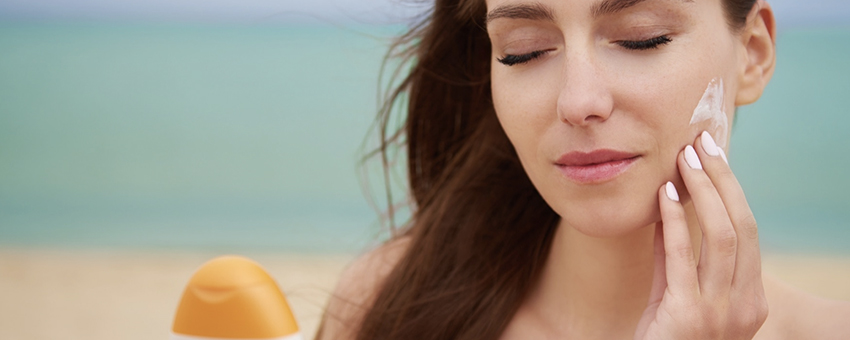
“The Sun. The bright sun, that brings back, not light alone, but new life, and hope, and freshness…,” wrote the great English novelist Charles Dickens. So many of our poems and songs give tribute to this superstar of our solar system, this energy-giving ball of fire that radiates light and heat that makes it possible for us to survive.
We need the sun to exist. It enables our bodies to produce vitamin D, which helps metabolize calcium to keep our bones strong and our skin healthy. Yet, with all the fantastic benefits that the sun provides, it can also be your skin’s worst enemy. Therefore, incorporating SPF in your skincare routine, along with skin treatments such as skin-tightening and exfoliating facials, is a must. This article will explore why you absolutely should wear sun protection factor or SPF every day.
Why SPF Should Be A Daily Habit
Reason No.1: SPF intercepts premature skin aging
Did you know that 90% of the visible decline in your skin condition can be traced to the sun? Overexposure to the sun’s ultraviolet (UV) rays, both UVA and UVB, can destroy your skin cells, causing premature skin aging.
Leathery, wrinkly, sagging, and coarse. This is how one can best describe skin that’s aged ahead of its time. Fortunately, this can be prevented by simply putting on some sunscreen.
The SPF in your sunscreen can protect you from the harmful effects of UV rays by creating a defensive barrier against the sun. It essentially blocks and reduces the UV radiation that is absorbed by the skin. This insulates the connective tissues of collagen and elastin that give your skin its supple, youthful appearance.
Reason No.2: SPF helps prevent skin disorders and skin cancer
If great-looking skin isn’t an adequate reason for you to wear SPF, then perhaps preserving your skin’s health—even your very life—will give you enough motivation.
Overexposure to the sun can wreak havoc on your skin’s DNA, molecules that dictate how your cells will look and function. Studies show that the sun can continue to prompt cancerous DNA damage even after it sets.
Prolonged exposure can mangle large amounts of DNA material. UV radiation stimulates specific proteins to produce free radicals that eventually dump their energy into DNA material, impairing it in the process. When a significant quantity of DNA is destroyed, our cells can lose control of their functions. This may result in skin conditions such as actinic keratosis or sun warts (sandpaper texture and scaly spots), solar urticaria (flat red marks or raised red or white weals), and PMLE skin (skin rashes).
In extreme cases, it can lead to the most prevalent type of cancer today: skin cancer. The Skin Cancer Foundation reports that 1 in 5 Americans will get skin cancer by the age of 70. The good news is that this can be prevented. Using an SPF of 15 and above (the higher the SPF number, the more protection you have) can reduce the risk of having squamous cell carcinoma by about 40% and melanoma by about 50%.
Reason No.3: SPF defends from ever-present UV rays
On the surface, it may seem that you’re less likely to experience sun damage during the colder months of the year. Although the UV index (the measure of UV radiation) is lower during cooler seasons, you can still get burned in the fall and winter. And it isn’t only the rays from above that can harm your skin. You also have to consider that sunlight can bounce off the fresh, white snow, doubling your UV exposure.
Neither does residing in overcast climates make you immune from sun damage. UV light is so powerful that about 80% of it can pass through clouds. This means that regardless of location, no one can have extended exposure without being affected by it.
UV rays are also potent enough to penetrate windows. This means your skin is also at risk of sun damage even if you’re driving or doing desk work by a window.
To keep you safe wherever you are, wear sunscreen with a minimum of SPF 30. If you’re headed outdoors, apply it 15 to 30 minutes before you step outside. This will give your skin time to absorb the SPF. Reapply every two hours.
Reason No.4: SPF can help shield you even as the ozone layer is thinning out
The ozone layer is a sparse mantle in the earth’s upper atmosphere that absorbs the sun’s rays and protects us from its harmful effects. However, greenhouse gas emissions are depleting it. While the ozone layer remains to be a powerful shield, it can no longer perfectly shield us from the sun’s harmful UV radiation.
Applying sunscreen every day can play a vital part in your overall defensive strategy against the damaging effects of UV light. Make sure you also seek shade and cover up wherever and whenever you can.
Choosing the right sunscreen
Do you want to be sure that your sunscreen is topnotch? Then, choose a mineral sunscreen! This type of sunscreen is a better and much healthier alternative to chemical sunscreens. Mineral sunscreens, also called physical blockers, contain safe and effective ingredients such as titanium dioxide and zinc oxide and can last longer in direct UV light. Not only are they ideal for children and those with sensitive skin, but their natural, active components are environmentally friendly.
You don’t have to constantly hide in the shadows and stop doing the activities you love to protect your skin from sun damage. Just be consistent about wearing sunscreen every day, whether indoors or outdoors. And don’t forget to choose a mineral sunscreen. Both your skin and the environment will surely thank you for it!

